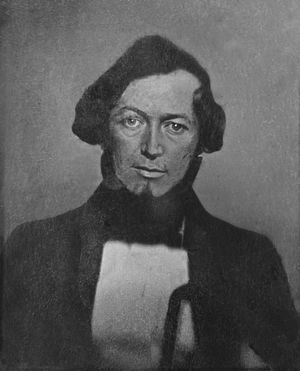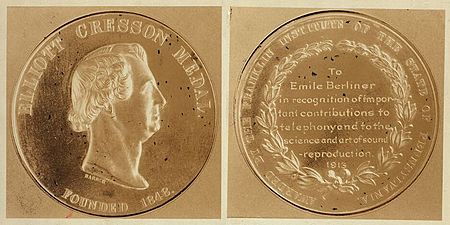Elliott Cresson facts for kids
Quick facts for kids
Elliott Cresson
|
|
|---|---|
 |
|
| Born | March 2, 1796 Philadelphia
|
| Died | February 20, 1854 (aged 57) Philadelphia
|
| Occupation | Merchant, philanthropist |
Elliott Cresson (born March 2, 1796 – died February 20, 1854) was an American who loved to help others. He was a philanthropist, which means he gave money and time to many good causes. After working as a merchant for a short time, he used his wealth to support important projects.
Cresson created the Elliott Cresson Medal for the Franklin Institute in 1848. He also helped start and manage the Philadelphia School of Design for Women. This school is now known as the Moore College of Art and Design. Elliott Cresson was a member of the Religious Society of Friends, also known as Quakers. He strongly supported the American Colonization Society in Philadelphia. This group worked to fight slavery by helping former slaves and free African Americans move to colonies in Liberia, Africa.
Contents
Early Life and Work
Elliott Cresson was born in Philadelphia, Pennsylvania, on March 2, 1796. He was the first child of John Elliott Cresson and Mary Warder Cresson. His family had lived in the United States for many generations.
When his father died in 1814, Elliott continued to live with his mother. He never married. In 1818, his uncle, Caleb Cresson, Jr., gave him control of a very successful business. This business involved buying and selling goods, which is called a mercantile business. By 1824, Cresson decided to leave the business. He wanted to spend his time and money helping others instead.
Helping People Move to Liberia
Cresson was very interested in the idea of helping freed slaves and free African Americans move to Africa. He believed that if former slaves lived in a new place, surrounded by a mostly Black culture, they would have a better chance to succeed.
He joined the Young Men's Colonization Society in Philadelphia. This group was part of the larger American Colonization Society. Cresson quickly became one of its most active members. He noticed that the national organization was having money problems and warned them about it.
In 1832 and 1833, Cresson traveled to England and Liberia to promote the idea of colonization. The Philadelphia and New York City groups decided to work more independently. The Philadelphia group founded a colony called Port Cresson in Liberia. Today, this place is known as Buchanan, Liberia. Their goal was for the new Black settlers to control the Saint John River. This would help stop the trade of about 1200 slaves each month.
Cresson traveled to Liberia in early 1833 to help set up the colony. A poet named Lydia Sigourney even wrote a poem for him. Part of it said:
Sad Afric's hand hath bound thee,
Among her jewels rare;—
Her talisman is round thee,
Her tearful, grateful prayer.
Go forth—God's peace possessing!
To all mankind a friend;—
Full be thy cup of blessing,
Where'er thy wanderings tend!
By 1833, another abolitionist, William Lloyd Garrison, started to criticize the American Colonization Society. He said it was actually helping to keep slavery going. Cresson tried to fix the damage caused by Garrison's statements. He even wrote to Garrison directly.
Sadly, the Port Cresson colony was attacked in 1835 by Bassa tribesmen. These tribesmen were encouraged by Spanish slave traders. All the buildings were destroyed, and 20 of the 126 colonists were killed. The rest escaped to a nearby colony called Edina. A month later, a new colony was started at Bassa Cove.
Thanks to Cresson and his New York partners, the American Colonization Society was reorganized. They focused on being more responsible with their money. Cresson traveled through the Southern states in the late 1830s to promote colonization in Liberia. He wrote in 1840 that many areas, especially Kentucky, seemed ready to send their slaves to Liberia. Many believed that freeing slaves depended on them moving out of the United States. Slaveholders often expected to be paid for losing their workers.
The Franklin Institute Medal
In late 1824, Elliott Cresson became a lifetime member of the Franklin Institute. This institute was a place for science and education. In 1846, he announced that he wanted to create a special medal.
In 1848, Cresson gave $1,000 to start the Elliott Cresson Medal. This was a gold medal given for important discoveries in arts and sciences. It was also awarded for inventing or improving useful machines. People could also earn it for new ways of making things or for excellent craftsmanship. The first medals were given out in 1875 to six different groups or people.
Cresson also suggested giving out silver medals in 1850. These would be given in 1851 to the biggest producers of coffee, sugar, palm oil, and cotton in the Pennsylvania colonies of Liberia. The Franklin Institute agreed to this award, but these silver medals were never actually given.
Supporting Women's Education
In 1850, a woman named Sarah Peter wrote to the Franklin Institute. She wanted her drawing class of about 20 young women to become a part of the Institute. The Franklin Institute then created and oversaw the Philadelphia School of Design for Women from 1850 to 1853.
In 1853, a group of 17 men were chosen to officially start the school. Elliott Cresson was one of these directors. He was elected president at their first meeting. Cresson was very excited about helping the school, but his work was cut short when he died. The school grew and became very successful. In 1989, it was renamed the Moore College of Art and Design.
Other Interests and Legacy
Elliott Cresson had many other interests. In 1829, he wrote to James Madison, who was a former president and one of the Founding Fathers of the United States. Madison, who was 79 years old, sent Cresson a sample of his own handwriting. He also sent autographs from George Washington and Thomas Jefferson.
Cresson was a member of the Athenaeum of Philadelphia, which is a special library. He also bought shares in the Pennsylvania Academy of the Fine Arts. In his will, Cresson left money to the city of Philadelphia. This money was meant to plant and replace shade trees. He specifically said to avoid certain "foreign trash" trees like the Lombardy Poplar.
Cresson died in Philadelphia on February 20, 1854, at the age of 58. He was buried at The Woodlands Cemetery in Philadelphia. A town in Pennsylvania, Cresson, Pennsylvania, was named in his honor.
In his will, Cresson gave $500 to the artist Thomas Sully. Sully had painted two portraits of Cresson during his lifetime. Cresson also left money to William Bacon Stevens, a church leader and historian. Other people and groups, including his sister's three sons and the Athenaeum of Philadelphia, also received money from his will.
The Franklin Institute continued to give out the Elliott Cresson Medal for many years. It was also known as the Elliott Cresson Gold Medal. In 1998, the Institute changed its awards system. The Elliott Cresson Medal was replaced by The Benjamin Franklin Medals. In total, 268 people or groups received the Elliott Cresson Medal during its history.


